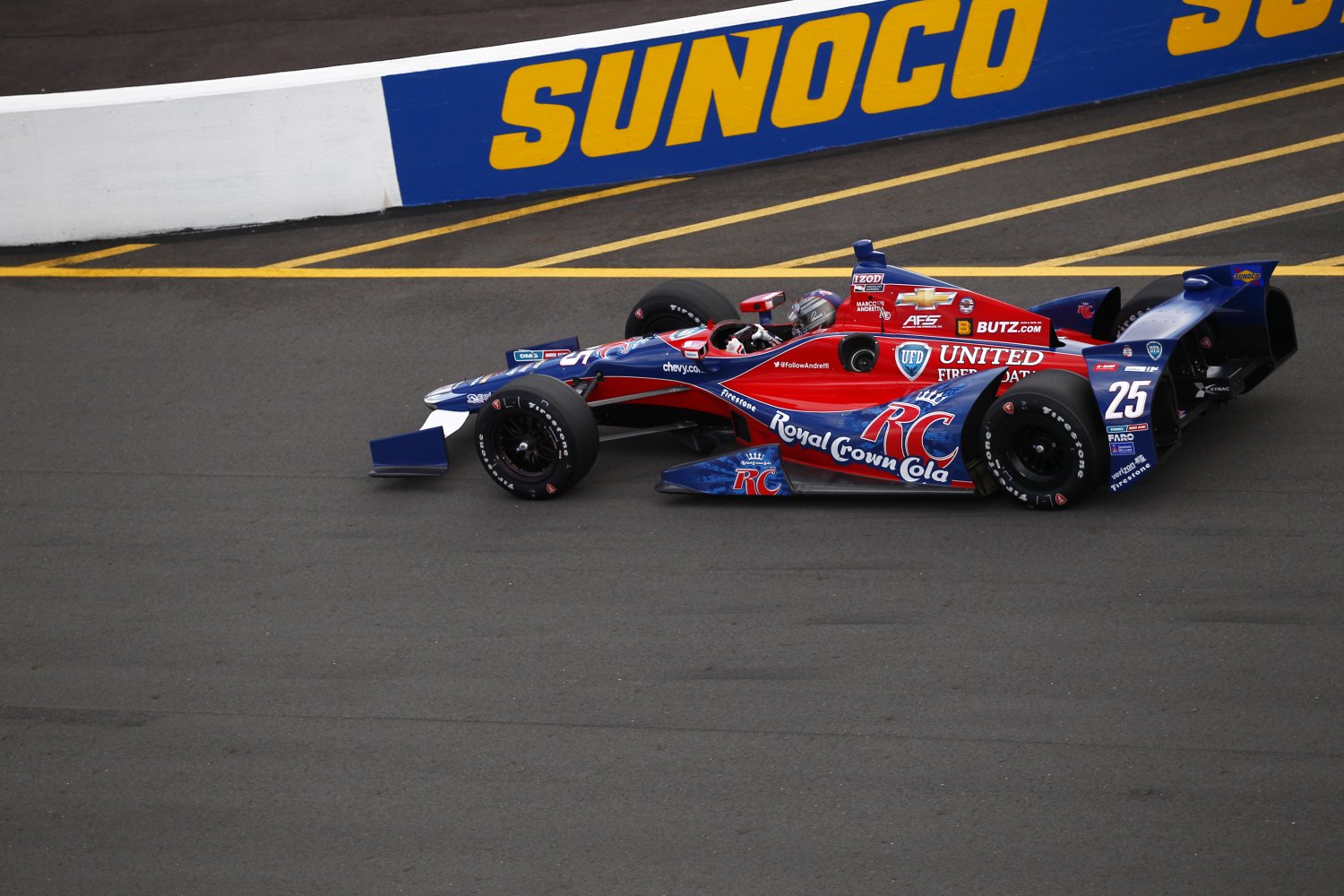No Hard Feelings: IndyCar Finally Returns to Pocono
 |
| Mario Andretti at Pocono Thursday gives a Thumbs Up |
Indy cars return to race at Pocono Raceway for the first time in 24 years this weekend, and the guy for whom Andretti Road here was named says he can't wait.
Mario Andretti, 73, has called the track weekly, looking for updates, even offering his help. He lives nearby, about 35 miles away. "He's like a little kid," said Brandon Igdalsky, the racetrack's 37-year-old president and chief executive officer. "He's so excited the race is back in his backyard."
The Izod IndyCar Series—the open-wheel racers that run in the Indianapolis 500—is holding a 400-mile race Sunday at Pocono, which is 100 miles from New York.
The track, a unique 2½-mile tri-oval off Interstate 80 nicknamed the Tricky Triangle, has played host
 |
| Marco Andretti was fastest on Thursday |
to two Nascar top-series stock-car races each summer since 1982. But Pocono, with relatively flat corners, was really built for the lower, lighter and faster Indy cars.
Andretti, A.J. Foyt, Rick Mears and Al Unser Sr. were among those who raced (and won) at what was then a 500-mile race at Pocono from 1971 to 1989. Then they left. The drivers thought the track was unsafe, and Pocono said the races were unprofitable.
The spokesman for the track in those days was its founder, Dr. Joseph Mattioli, almost always referred to simply as "Doc," a dentist from northeast Philadelphia who turned a 1,000-acre spinach farm into a track he thought could be the Indy of the East.
And, for a while, the crowds at Pocono were good—until Indy-car racing split into two factions in the late 1970s. Mattioli took one side; Andretti and most top drivers took the other. The 1981 race had much-slower sprint cars.
The Indy cars left after the 1989 race, seemingly for good, and Doc Mattioli was hardly sorry to see them take off. Mario Andretti, after which Mattioli had named a road at Pocono, and his son, Michael, were among the loudest critics of the family-owned track. Mattioli was once quoted as calling Indy-car drivers "prima donnas."
"I think Doc is up there smiling right now. I really do," Mario Andretti said in a telephone interview this week. "There were some issues, you know, that obviously kept us away, but that's all behind us now in every way.
"Pocono has done everything they needed to do to bring the speedway right up to the absolute top standards, with every safety aspect. Right now, it's a wonderful facility. We had some issues back then, but, you know, that's all history. I'm glad that my family is embracing it again, and I'm sure Doc is up there approving of it."
Mattioli vowed many times that Indy cars would never return to Pocono in his lifetime, and he was right.
He died at age 86 in January 2012, but not before turning the track over to his grandchildren, including Igdalsky. Before Mattioli's death, the track had been repaved and barriers installed. Gone were the tilted, boilerplate walls, the washboard asphalt and raggedy catch fences.
The tough times were over. Doc was gone, and Igdalsky wasn't interested in bringing back Indy cars—until he met Randy Bernard, then the chief executive of IndyCar, at a race in St. Petersburg, Fla., two months after Mattioli's death.
Doc's wife of 63 years, Dr. Rose Mattioli, a former podiatrist, is still alive, and, as Igdalsky said of his grandmother, "She always had a soft spot for the Indy-car guys. When the conversation started, we went to her, and she said, 'Whatever you got to do, let's make this happen.'"
Nascar and Indy-car racing had virtually flip-flopped in the intervening years. Nascar drivers like Dale Earnhardt Jr. are celebrities, their public appearances practically mob scenes. Indy-car drivers are comparatively anonymous, more famous for other roles, like Helio Castroneves—the current leader in the driver standings—who has competed on "Dancing with the Stars."
Igdalsky commissioned fan surveys of Pocono fans and was somewhat surprised with the results. Those who had gone to the Indy-car races wanted them back, and enough Nascar fans said they were interested in attending an Indy-car race.
Pocono signed on for three years to host a 400-mile Indy-car race, and Igdalsky has been encouraged by how the cars, redesigned last year, have taken to the racetrack in two recent tests. Of Sunday's race, the Pocono IndyCar 400, he said, "I think it's going to be a damn good show, I'll tell you that."
"The track is so different and it makes it very difficult to set up an Indy car there," said James Hinchcliffe, a driver for Michael Andretti's race team. "But from the testing, I can assure you that we are going to have a great race. It's very fast. I think it's going to be a similar kind of show to Indianapolis."
Grandstand tickets for adults to Sunday's race range from $25 to $75, only slightly less than the $45 to $85 range for similar Nascar tickets. Igdalsky said sales have matched expectations. He is optimistic that the race will become more popular next year.
Igdalsky, who was a 13-year-old boy growing up in the Philadelphia suburbs when the Indy cars last raced at Pocono, was asked what he thought Doc would tell him if he found out the Indy cars had returned. "Are you out of your mind?" Igdalsky said his grandfather would say.
He laughed, then said, "I think in one aspect, he'd probably be a little [upset] and bitter. Typical Doc style. But at the same time, I think he'd be a little excited. I think after he saw the product and the changes that have been made in the sport, he'd be much more comfortable with it." Wall Street Journal
